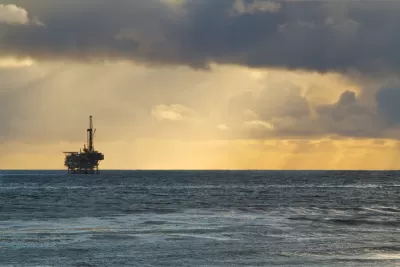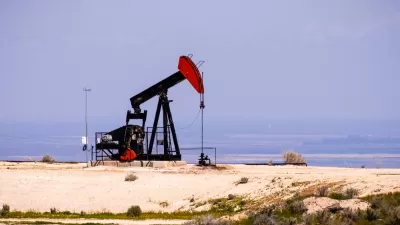In a major blow to former President Obama's restrictions on offshore drilling in sensitive areas, Interior Secretary Ryan Zinke announced that he would open the Outer Continental Shelf in four regions: Pacific, Arctic, Atlantic, and the Gulf Coast.

he Washington Post.
He said the Bureau of Ocean and Energy Management [a division of the Interior Department created in 2010] has identified 47 potential areas where industry companies can buy leases between 2019 and 2024, when the proposed period would begin and end.
One reason for the announcement to open the Outer Continental Shelf to drilling is a desire by the Trump Administration to achieve what they call "energy dominance" as opposed to the term that has developed under the Nixon Administration, energy independence.
"Zinke said the proposal is consistent with President Trump’s executive order in April to widen energy exploration," adds Fears. "The 'America-First Offshore Energy Strategy' will make millions of acres of federal waters eligible for oil and gas leasing, just four months after President Barack Obama withdrew these areas from possible development," reported Juliet Eilperin for The Washington Post on April 28 2017.
Opposition
The action "is opposed by governors from New Jersey to Florida [both Republican], nearly a dozen attorneys general, more than 100 U.S. lawmakers and the Defense Department," reports Fears.
"California officeholders were also quick to criticize the plan," reports Kurtis Alexander for the San Francisco Chronicle.
Gov. Jerry Brown as well as Democratic Sens. Dianne Feinstein and Kamala Harris called it short-sighted and not in the interest of West Coast residents, including the tourism and fishing sectors. State Attorney General Xavier Becerra said he would look into legal options to halt new oil operations.
Brown joined with his two West Coast counterparts, Oregon Governor Kate Brown and Washington Governor Jay Inslee, to issue a joint statement to condemn Zinke's action.
Support
“This announcement could help California increase our domestic energy production,” said Catherine Reheis-Boyd, president of the Western States Petroleum Association, an industry group, adds Alexander.
“Currently, we import over 1 million barrels of oil in supertankers from overseas locations each and every day,” a practice that she noted poses ecological hazards of its own.
Good for conservation?
"Responsibly developing our energy resources on the Outer Continental Shelf in a safe and well-regulated way is important to our economy and energy security, and it provides billions of dollars to fund the conservation of our coastlines, public lands and parks," said Secretary Zinke in the Interior Department's press release on Jan. 4.
"The important thing is we strike the right balance to protect our coasts and people while still powering America and achieving American Energy Dominance," he added.
By proposing to open up nearly the entire OCS for potential oil and gas exploration, the United States can advance the goal of moving from aspiring for energy independence to attaining energy dominance,” said Vincent DeVito, Counselor for Energy Policy at Interior. “This decision could bring unprecedented access to America’s extensive offshore oil and gas resources and allows us to better compete with other oil-rich nations.”
As posted here Saturday, the U.S. is already on track to break the 1970 oil production record of 10 million barrels per day this year, if it hasn't already.
Process forward (per Interior Department announcement)
Public meetings will be held around the country starting on January 16, 2018, to receive comments on the Draft Proposed Program and to inform the Draft Programmatic EIS. Specific dates, times, and venues will be posted on BOEM’s website at https://www.boem.gov/National-Program/.
Online commenting begins on Monday, January 8, 2018.
FULL STORY: Trump administration plan would widely expand drilling in U.S. continental waters

Trump Administration Could Effectively End Housing Voucher Program
Federal officials are eyeing major cuts to the Section 8 program that helps millions of low-income households pay rent.

Planetizen Federal Action Tracker
A weekly monitor of how Trump’s orders and actions are impacting planners and planning in America.

Ken Jennings Launches Transit Web Series
The Jeopardy champ wants you to ride public transit.

Rebuilding Smarter: How LA County Is Guiding Fire-Ravaged Communities Toward Resilience
Los Angeles County is leading a coordinated effort to help fire-impacted communities rebuild with resilience by providing recovery resources, promoting fire-wise design, and aligning reconstruction with broader sustainability and climate goals.

When Borders Blur: Regional Collaboration in Action
As regional challenges outgrow city boundaries, “When Borders Blur” explores how cross-jurisdictional collaboration can drive smarter, more resilient urban planning, sharing real-world lessons from thriving partnerships across North America.

Philadelphia Is Expanding its Network of Roundabouts
Roundabouts are widely shown to decrease traffic speed, reduce congestion, and improve efficiency.
Urban Design for Planners 1: Software Tools
This six-course series explores essential urban design concepts using open source software and equips planners with the tools they need to participate fully in the urban design process.
Planning for Universal Design
Learn the tools for implementing Universal Design in planning regulations.
Ada County Highway District
Clanton & Associates, Inc.
Jessamine County Fiscal Court
Institute for Housing and Urban Development Studies (IHS)
City of Grandview
Harvard GSD Executive Education
Toledo-Lucas County Plan Commissions
Salt Lake City
NYU Wagner Graduate School of Public Service





























